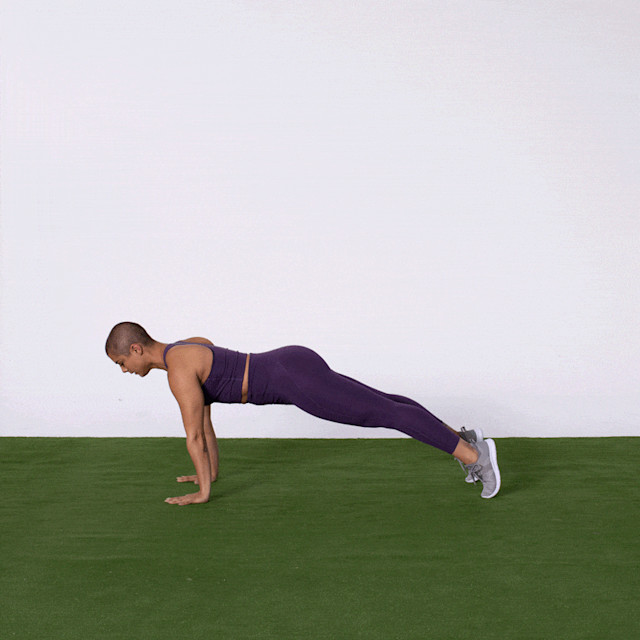Improve the effectiveness of every workout.
Before you strengthen, activate. Like stretches, muscle activation drills increase the flow of blood and nutrients to your muscles to improve flexibility. They also fire up your nervous system.
By applying a low level of resistance to your muscles, activations make the neurons that control them more sensitive. That way, when you get into the meat of your strength workout, those muscles automatically fire with greater intensity than they would have if you had gone straight into your strength sets.
“Muscle activation steps up your workouts,” says Equinox group fitness instructor Kristin Osbon in Orange County, California. She explains that, by performing targeted activation drills prior to workouts, exercisers are unlocking their muscles’ full potential. As a result, they reap greater strength and conditioning benefits.
However, standard activations like fire hydrants, donkey kicks, and arm circles get boring fast. That’s one reason Osborn’s workouts and classes combine dynamic, compound movements, often with resistance bands, to keep things interesting. They’re also more effective because they sync up multiple muscles or even groups of muscles at once.
Here, Osborn shares the best activations for every body part. Before your strength workouts, perform 1 to 2 sets of 10 to 15 reps of each exercise, with a goal of hitting a rate of perceived exertion of 6 to 7 (on a scale of 1 to 10). Maintain total-body tension and mentally focus on engaging your working muscles throughout each activation. Ideally, release and stretch body parts before you activate them.
In addition to the below combinations, it’s beneficial to do both pushing and pulling activations before upper-body workouts and at least one activation per body part before total-body routines.
The best muscle activations for: chest, shoulders, core, and triceps
Prior to pushing workouts, wake up your upper body’s anterior chain with these three drills. By moving your body in the transverse or rotational plane, they’ll also activate your abs and obliques.

Shoulder taps
Get in a high plank with your feet shoulder-width apart and shoulders stacked over wrists. Brace your core so that your body forms a straight line from head to heels. Lift one hand to tap the opposite shoulder, without tilting toward the side of your planted arm. Repeat with the other arm.

Push-up to rotation
Get in a high plank with your feet shoulder-width apart and shoulders stacked over wrists. Brace your core so that your body forms a straight line from head to heels. Lower into a push-up, then drive through your chest to extend your arms. Once your arms have reached extension, rotate your body to raise one hand straight toward the ceiling. Follow your hand with your eyes. Lower your hand back to the floor. Perform all reps, then switch sides and repeat.

Shoulder dislocation
Stand with feet wider than hips, arms extended down, pulling a resistance band taut with both hands. Raise your hands up, over, and behind your head, bringing them as close to the small of your back as you comfortably can. Reverse the motion to return to start.
The best muscle activations for: back, shoulders, and biceps
These activations work the upper body’s posterior chain, with an emphasis on the often overlooked upper-back muscles.

Band pull-apart
Stand with feet hip-width apart, arms extended straight in front of you, a mini band around your wrists, and palms facing each other. Brace your core. Squeeze your shoulder blades together to spread your arms out toward your sides. Pause, then bring your arms back in front of you.

Face pull to external rotation
Stand with one foot slightly in front of the other and grab both handles of a resistance tube, with your arms in front of you and the tube taut. Brace your core. Pull the band toward you until elbows are in line with your shoulders, then rotate your shoulders to raise your hands directly over your elbows. Pause, then reverse the motion to return to start.

Straight arm pull-down
Secure a resistance tube around an anchor point higher than your head, hold one handle in each hand with arms extended in front of you, and step back until the band is taut. With your feet hip-width apart and hips pressed slightly back, pull the band down to your sides, ending at your hips. Pause, then slowly return to start.
The best muscle activations for: glutes, quads, and hamstrings
To increase strength and power in lower-body lifts, warm up with these exercises. While they work the entire lower body, they focus on the glutes for healthier movement patterns and injury prevention. These are best done after performing 5 to 10 minutes of low-intensity cardio.

Single-leg hip bridge
Lie faceup with your knees bent and feet flat on the floor. Raise one foot and brace your core. Drive through your planted foot’s heel and squeeze your glutes to raise your hips so that your body forms a straight line from head to the knee of your planted leg. Pause, then lower your hips to the floor. Perform all reps, then switch sides and repeat.

Single-leg RDL to windmill
Stand with your feet just narrower than hips, with your arms extended overhead. Lift one foot. Hinge the hip of your standing leg to bring your arms, torso, and raised leg into one straight line, parallel to the floor. Pause, then rotate your body to face the side of your lifted leg, your arms straight to your sides, one toward the ceiling, one toward the floor. Reverse the motion to return to standing. Perform all reps, then switch sides and repeat.

Hip lift to clamshell
Lie on your side with your forearm down, shoulder stacked over elbow, a mini band around your thighs, knees bent and stacked, feet stacked. Press your forearm and feet into the floor and simultaneously raise your hips and left knee toward the ceiling. Perform all reps, then switch sides and repeat.
Photography by Carissa Gallo. Art direction by Kathryn Marx.
